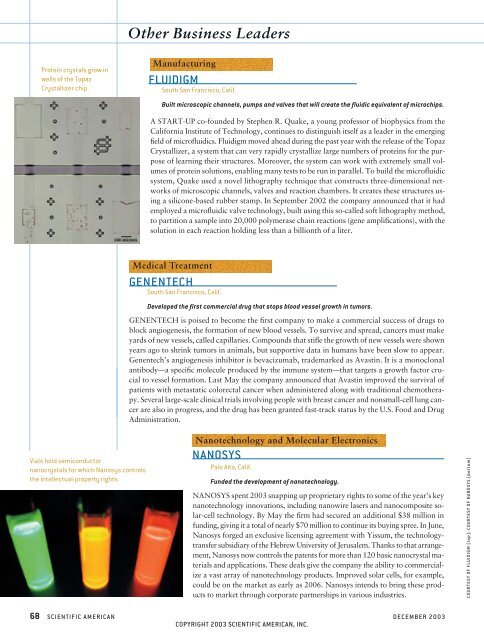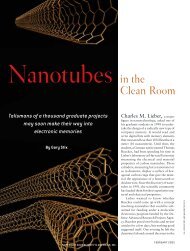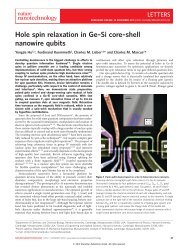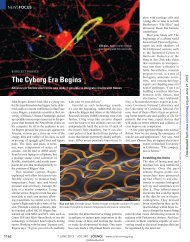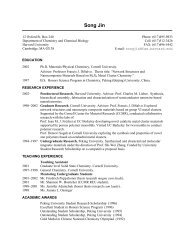download pdf - Lieber Research Group - Harvard University
download pdf - Lieber Research Group - Harvard University
download pdf - Lieber Research Group - Harvard University
You also want an ePaper? Increase the reach of your titles
YUMPU automatically turns print PDFs into web optimized ePapers that Google loves.
Other Business Leaders<br />
Protein crystals grow in<br />
wells of the Topaz<br />
Crystallizer chip.<br />
Manufacturing<br />
FLUIDIGM<br />
South San Francisco, Calif.<br />
Built microscopic channels, pumps and valves that will create the fluidic equivalent of microchips.<br />
A START-UP co-founded by Stephen R. Quake, a young professor of biophysics from the<br />
California Institute of Technology, continues to distinguish itself as a leader in the emerging<br />
field of microfluidics. Fluidigm moved ahead during the past year with the release of the Topaz<br />
Crystallizer, a system that can very rapidly crystallize large numbers of proteins for the purpose<br />
of learning their structures. Moreover, the system can work with extremely small volumes<br />
of protein solutions, enabling many tests to be run in parallel. To build the microfluidic<br />
system, Quake used a novel lithography technique that constructs three-dimensional networks<br />
of microscopic channels, valves and reaction chambers. It creates these structures using<br />
a silicone-based rubber stamp. In September 2002 the company announced that it had<br />
employed a microfluidic valve technology, built using this so-called soft lithography method,<br />
to partition a sample into 20,000 polymerase chain reactions (gene amplifications), with the<br />
solution in each reaction holding less than a billionth of a liter.<br />
Medical Treatment<br />
GENENTECH<br />
South San Francisco, Calif.<br />
Developed the first commercial drug that stops blood vessel growth in tumors.<br />
GENENTECH is poised to become the first company to make a commercial success of drugs to<br />
block angiogenesis, the formation of new blood vessels. To survive and spread, cancers must make<br />
yards of new vessels, called capillaries. Compounds that stifle the growth of new vessels were shown<br />
years ago to shrink tumors in animals, but supportive data in humans have been slow to appear.<br />
Genentech’s angiogenesis inhibitor is bevacizumab, trademarked as Avastin. It is a monoclonal<br />
antibody—a specific molecule produced by the immune system—that targets a growth factor crucial<br />
to vessel formation. Last May the company announced that Avastin improved the survival of<br />
patients with metastatic colorectal cancer when administered along with traditional chemotherapy.<br />
Several large-scale clinical trials involving people with breast cancer and nonsmall-cell lung cancer<br />
are also in progress, and the drug has been granted fast-track status by the U.S. Food and Drug<br />
Administration.<br />
Vials hold semiconductor<br />
nanocrystals for which Nanosys controls<br />
the intellectual-property rights.<br />
Nanotechnology and Molecular Electronics<br />
NANOSYS<br />
Palo Alto, Calif.<br />
Funded the development of nanotechnology.<br />
NANOSYS spent 2003 snapping up proprietary rights to some of the year’s key<br />
nanotechnology innovations, including nanowire lasers and nanocomposite solar-cell<br />
technology. By May the firm had secured an additional $38 million in<br />
funding, giving it a total of nearly $70 million to continue its buying spree. In June,<br />
Nanosys forged an exclusive licensing agreement with Yissum, the technologytransfer<br />
subsidiary of the Hebrew <strong>University</strong> of Jerusalem. Thanks to that arrangement,<br />
Nanosys now controls the patents for more than 120 basic nanocrystal materials<br />
and applications. These deals give the company the ability to commercialize<br />
a vast array of nanotechnology products. Improved solar cells, for example,<br />
could be on the market as early as 2006. Nanosys intends to bring these products<br />
to market through corporate partnerships in various industries.<br />
COURTESY OF FLUIDIGM (top); COURTESY OF NANOSYS (bottom)<br />
68 SCIENTIFIC AMERICAN DECEMBER 2003<br />
COPYRIGHT 2003 SCIENTIFIC AMERICAN, INC.


